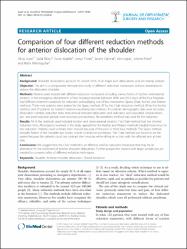| dc.contributor.author | Güler, Olcay | |
| dc.contributor.author | Ekinci, Şafak | |
| dc.contributor.author | Akyıldız, Faruk | |
| dc.contributor.author | Tirmik, Üzeyir | |
| dc.contributor.author | Çakmak, Selami | |
| dc.contributor.author | Uǧraş, Ali Akın | |
| dc.contributor.author | Pişkin, Ahmet | |
| dc.contributor.author | Mahiroğulları, Mahir | |
| dc.date.accessioned | 10.07.201910:49:13 | |
| dc.date.accessioned | 2019-07-10T20:01:25Z | |
| dc.date.available | 10.07.201910:49:13 | |
| dc.date.available | 2019-07-10T20:01:25Z | |
| dc.date.issued | 2015 | en_US |
| dc.identifier.citation | Güler, O., Ekinci, Ş., Akyıldız, F., Tirmik, Ü., Çakmak, S., Uǧraş, A. A. ... Mahiroğulları, M. (2015). Comparison of four different reduction methods for anterior dislocation of the shoulder. Journal of Orthopaedic Surgery and Research, 10. https://dx.doi.org/10.1186/s13018-015-0226-4 | en_US |
| dc.identifier.issn | 1749-799X | |
| dc.identifier.uri | https://dx.doi.org/10.1186/s13018-015-0226-4 | |
| dc.identifier.uri | https://hdl.handle.net/20.500.12511/3260 | |
| dc.description | WOS: 000355166800001 | en_US |
| dc.description | PubMed ID: 26016671 | en_US |
| dc.description.abstract | Background: Shoulder dislocations account for almost 50 % of all major joint dislocations and are mainly anterior. Objective: The aim is a comparative retrospective study of different reduction maneuvers without anesthesia to reduce the dislocated shoulder. Methods: Patients were treated with different reduction maneuvers, including various forms of traction and external rotation, in the emergency departments of four training hospitals between 2009 and 2012. Each of the four hospitals had different treatment protocols for reduction and applying one of four maneuvers: Spaso, Chair, Kocher, and Matsen methods. Thirty-nine patients were treated by the Spaso method, 47 by the Chair reduction method, 40 by the Kocher method, and 27 patients by Matsen's traction-countertraction method. All patients' demographic data were recorded. Dislocation number, reduction time, time interval between dislocation and reduction, and associated complications, pre- and post-reduction period, were recorded prospectively. No anesthetic method was used for the reduction. Results: All of the methods used included traction and some external rotation. The Chair method had the shortest reduction time. All surgeons involved in the study agreed that the Kocher and Matsen methods needed more force for the reduction. Patients could contract their muscles because of the pain in these two methods. The Spaso method includes flexion of the shoulder and blocks muscle contraction somewhat. The Chair method was found to be the easiest because the patients could not contract their muscles while sitting on a chair with the affected arm at their side. Conclusions: We suggest that the Chair method is an effective and fast reduction maneuver that may be an alternative for the treatment of anterior shoulder dislocations. Further prospective studies with larger sample size are needed to compare safety of different reduction techniques. | en_US |
| dc.language.iso | eng | en_US |
| dc.publisher | BioMed Central | en_US |
| dc.rights | info:eu-repo/semantics/openAccess | en_US |
| dc.rights | Attribution 4.0 International | * |
| dc.rights.uri | https://creativecommons.org/licenses/by/4.0/ | * |
| dc.subject | Shoulder | en_US |
| dc.subject | Anterior Shoulder Dislocation | en_US |
| dc.subject | Closed Reduction | en_US |
| dc.title | Comparison of four different reduction methods for anterior dislocation of the shoulder | en_US |
| dc.type | article | en_US |
| dc.relation.ispartof | Journal of Orthopaedic Surgery and Research | en_US |
| dc.department | İstanbul Medipol Üniversitesi, Tıp Fakültesi, Cerrahi Tıp Bilimleri Bölümü, Ortopedi ve Travmatoloji Ana Bilim Dalı | en_US |
| dc.authorid | 0000-0002-0022-0439 | en_US |
| dc.authorid | 0000-0001-6534-9201 | en_US |
| dc.authorid | 0000-0002-7794-9308 | en_US |
| dc.identifier.volume | 10 | en_US |
| dc.relation.publicationcategory | Makale - Uluslararası Hakemli Dergi - Kurum Öğretim Elemanı | en_US |
| dc.identifier.doi | 10.1186/s13018-015-0226-4 | en_US |
| dc.identifier.wosquality | Q2 | en_US |
| dc.identifier.scopusquality | Q2 | en_US |



















